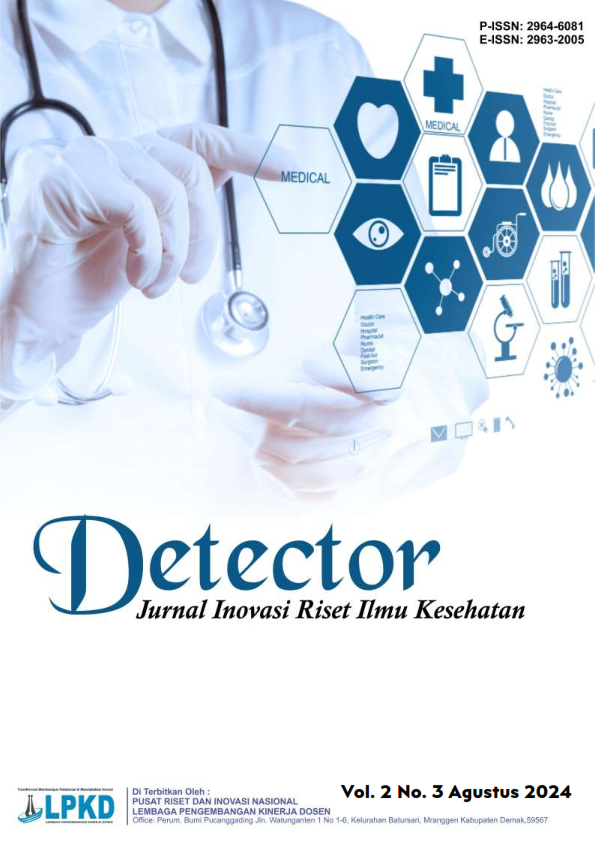Penerapan Teknik Relaksasi Nafas Dalam terhadap Intensitas Nyeri dengan Asuhan Keperawatan Post Op Apendiktomi di Ruangan Bedah Rumah Sakit Umum Daerah Palembang Bari
DOI:
https://doi.org/10.55606/detector.v2i3.4191Keywords:
Breathing Relaxation Techniques, Post Op Appendectomy Patients, General HospitalAbstract
Background : Appendectomy is a surgical procedure to remove the appendix which is done as soon as possible to reduce the risk of perforation. Nursing problems that arise after appendectomy is acute pain. Objectives: Gaining real experience and knowledge and being able to document the application of deep breathing relaxation techniques is an appropriate non-pharmacological action in reducing pain scale. Method: this type of scientific paper uses a descriptive method with a descriptive case study approach with a case study approach to explore the problem of nursing care carried out on two patients carried out on June 15 - 20 2021. Results: from the results of nursing care to Mrs "S" and Mr "M" with a nursing diagnosis in the first patient, namely acute pain related to physical injury agents (eg abscess, amputation, burns, cuts, heavy lifting, surgical procedures, trauma, excessive physical exercise), impaired sense of comfort related to symptoms of the disease ( pain), impaired physical mobility related to decreased muscle strength (pain), and the second patient's diagnosis was acute pain related to physical injuring agents (eg abscess, amputation, burns, cuts, heavy lifting, surgical procedures, trauma, excessive physical exercise), discomfort related to symptoms of disease (pain), anxiety related to situational crises, lack of exposure to information, impaired physical mobility associated with decreased muscle strength (pain). The interventions in both patients were: identification of location, characteristics, duration, frequency, quality and intensity of pain, identification of pain scale, identification of non-verbal pain responses. The evaluation of the first patient had a pain intensity scale of 6 (moderate), and the second patient a pain scale of 7 (severe). The results of the study in the Surgery Room of the Palembang Bari Regional General Hospital after the deep breathing relaxation technique was carried out in the first patient on a pain scale of 6 (moderate) to 3 (mild), and the second patient pain scale of 7 (severe) to 4 (moderate). Conclusion: Progress notes to both patients on the application of deep breathing relaxation techniques to reduce pain intensity. The results of the nursing evaluation of the problem were partially resolved.
Downloads
References
Agung, S. (2013). Pengaruh pemberian teknik relaksasi nafas dalam terhadap tingkat nyeri pada pasien post operasi umum. Surakarta.
Ahmed, S., Makama, J., & others. (2014). Epidemiology of appendicitis in northern Nigeria: A 10-year preview. Retrieved from http://www.ssajm.org on Tuesday, November.
Amalina, A. (2018). Hubungan leukosit pre operasi dengan kejadian komplikasi pasca operasi apendiktomi pada pasien apendisitis perforasi di RSUP DR. M. Djamil Padang. Jurnal Kesehatan Andalas, 7(4), 491-497.
Benson, H., & Proctor, W. (2000). Dasar-dasar respon relaksasi (1st ed.). (Alih Bahasa). Bandung: Penerbit Kaifa.
Budiono, & Pertami, S. B. (2015). Konsep dasar keperawatan. Jakarta: Bumi Medika.
Dodoi. (2018). Penerapan teknik relaksasi nafas dalam untuk penurunan nyeri di Puskesmas Petanang (KTI), Lubuk Linggau.
Hariyanto, A. (2015). Buku ajar keperawatan medikal bedah 1 dengan diagnosis NANDA internasional. Jogjakarta.
Hidayat, A. A. (2009). Pengantar kebutuhan manusia: Aplikasi konsep dan keperawatan. Jakarta: Salemba Medika.
PPNI. (2016). Standar diagnosis keperawatan Indonesia: Definisi dan indikator diagnostik (1st ed.). Jakarta: Dewan Pengurus Pusat Persatuan Perawat Nasional Indonesia.
Sahar, H., & Riyani. (2016). Efektivitas relaksasi benso dan nafas dalam terhadap perubahan tingkat kecemasan (Skripsi). Makassar, Indonesia: UIN Alauddin.
SDKI, DPP, & PPNI. (2017). Standar diagnosa keperawatan Indonesia 1. Jakarta: DPPNI.
Smeltzer, B. (2013). Keperawatan medikal bedah. Yogyakarta: Nuha Medika.
Solehati, T., & Kosasih, C. E. (2015). Konsep dan aplikasi relaksasi dalam keperawatan. Bandung: PT. Refika Aditama.
Susanto, J., & Mubarak, W. I. I. L. (2015). Buku ajar ilmu keperawatan dasar (2nd ed.; A. Suslia, Ed.). Jakarta: Salemba Medika.
TIM POKJA SIKI DPP PPNI. (2018). Standar diagnosis keperawatan Indonesia. Jakarta Selatan: Dewan Pengurus Pusat Persatuan Perawat Nasional Indonesia.
Wahit, L., & Suslia, A. (Eds.). (2015). Buku ajar ilmu keperawatan dasar (2nd ed.). Jakarta: Catur Sasongko.
World Health Organization. (2017). The World Health Organization.
Downloads
Published
How to Cite
Issue
Section
License
Copyright (c) 2024 Detector: Jurnal Inovasi Riset Ilmu Kesehatan

This work is licensed under a Creative Commons Attribution-ShareAlike 4.0 International License.








